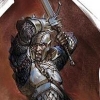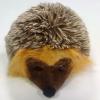Heightmap Generation through The Gimp
Hi guys. I am trying to generate some good height maps to render with a ray tracer using the gimp. Thus far I have had little luck. My problem is getting some noise on the image that is very smooth...That way the map won't jump too much. If anyone has some pointers or tutorials that could help I would be very appreciative. If I am not explaining myself well enough, just ask, and I can give you some examples of what I don't want to happen.
----------------------------------------------------"Plant a tree. Remove a Bush" -A bumper sticker I saw.
There was some info related to that around here somewhere...
hope this helps
hope this helps
-3D
The "solid noise" filter. (filters->renderen->clouds->solid noise. Propably filters->render->clouds->solid noise in the English version).
Why do my programs never work on other computers?
Quote:
Original post by Koroljov
The "solid noise" filter. (filters->renderen->clouds->solid noise. Propably filters->render->clouds->solid noise in the English version).
Yea, I tried that, but I still get weird "jumps." I'll render some examples in a bit here...
----------------------------------------------------"Plant a tree. Remove a Bush" -A bumper sticker I saw.
Ok. I used the Gimp's Solid Noise generator with the x and y settings both at 2.0. Here is the image generate and the one I am using to render terrain:

Now, this is what I get from that image:

I understand why this is. If we look at the first image blown up:

We can clearly see little rings around dark and light spots. These are what cause the problems. I need to know how to get rid of them. I have tried blurring, but that seems to accentuate them.

Now, this is what I get from that image:

I understand why this is. If we look at the first image blown up:

We can clearly see little rings around dark and light spots. These are what cause the problems. I need to know how to get rid of them. I have tried blurring, but that seems to accentuate them.
----------------------------------------------------"Plant a tree. Remove a Bush" -A bumper sticker I saw.
Um... what rings?
I've seen this before with other people's engines, and I'd say its a problem with your landscape engine, not gimp or the heightmap. The heightmap looks smooth enough to me.
I've seen this before with other people's engines, and I'd say its a problem with your landscape engine, not gimp or the heightmap. The heightmap looks smooth enough to me.
I like the DARK layout!
The problem is likely due to the fact that the pixel values are integers. Try stretching the range (White Balance or Stretch Contrast, IIRC0, and possibly interpolate on your program's side (i.e. convert to float, and double the resolution by inserting interpolated points). Something like that.
If that makes you feel better, GIMP's bump map filters suffer from exactly the same flaw.
If that makes you feel better, GIMP's bump map filters suffer from exactly the same flaw.
"Debugging is twice as hard as writing the code in the first place. Therefore, if you write the code as cleverly as possible, you are, by definition, not smart enough to debug it." — Brian W. Kernighan
I think those rings are caused by your display being in 16 bit mode. When I had my display in 32 bits mode the image was perfectly smooth, but when I changed to 16 bits it turned ugly.
I think maybe the problem isn't with gimp but in your own application.
I think maybe the problem isn't with gimp but in your own application.
It might just be that 8 bit images can't store enough detail for your purposes. GIMP can't handle higher that 8 bits per channel. There are two choices now. Programmatically smooth the image after loading it or move to a higher bit depth. Assuming your ray tracer can handle 16 bit grey scale images, you might look at:
CinePaint which is based on GIMP but geared towards movie production and handles greater colour depths. Going by the web site it doesn't like Windows much though.
Alternatively there is Netpbm which is a set of command line image processing utilities. This can convert between lots of image formats and do things like bit depth expansion, smoothing, etc. Much more awkward but you may have no choice.
dave j
CinePaint which is based on GIMP but geared towards movie production and handles greater colour depths. Going by the web site it doesn't like Windows much though.
Alternatively there is Netpbm which is a set of command line image processing utilities. This can convert between lots of image formats and do things like bit depth expansion, smoothing, etc. Much more awkward but you may have no choice.
dave j
This topic is closed to new replies.
Advertisement
Popular Topics
Advertisement
Recommended Tutorials
Advertisement








